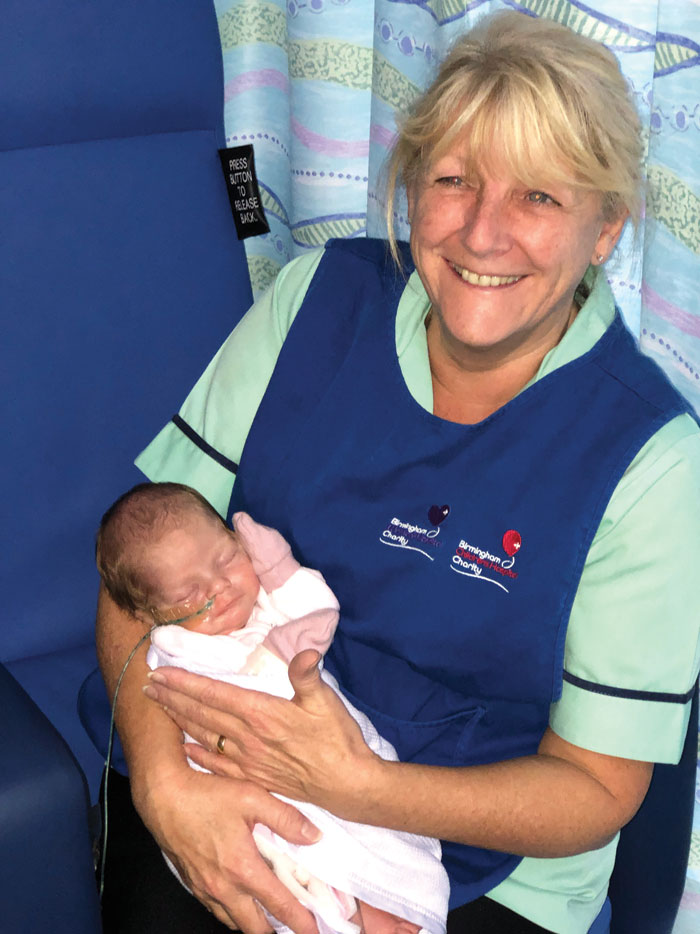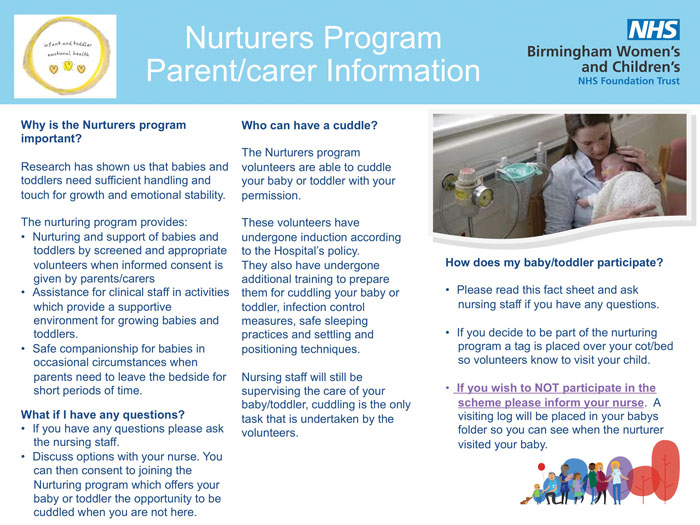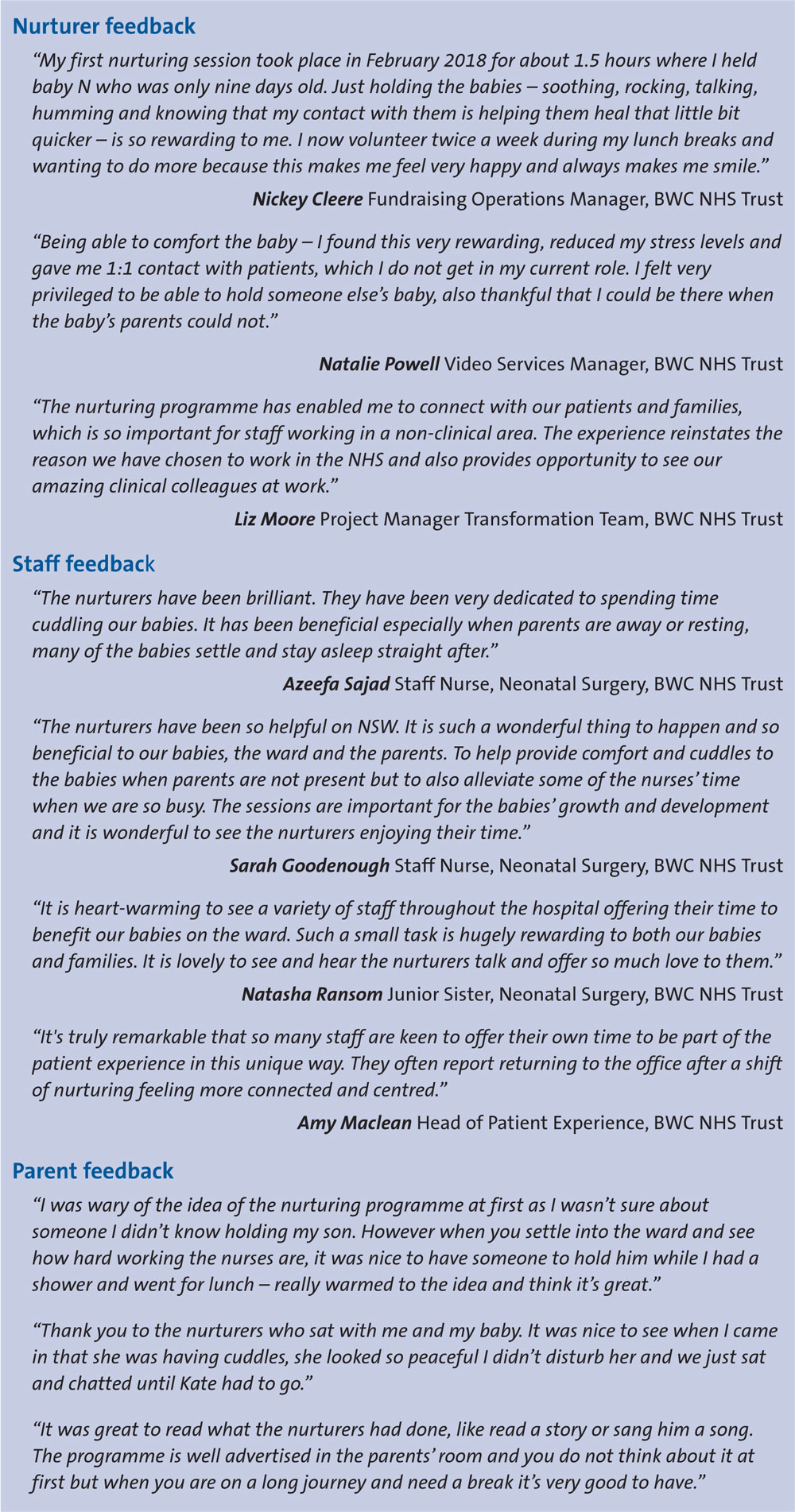A nurturing programme on the neonatal surgical ward
A recently introduced nurturing programme on the neonatal surgical ward at Birmingham Children’s Hospital makes use of volunteer members of staff who sit with babies to provide comfort, cuddles and reassurance when the parents are not present. The initiative is considered a huge success and deemed beneficial to the babies, their parents and the nursing staff.
Claire MurrayRN, RNCB, Neonatal Critical Care (405)
Ward Sister, Neonatal Surgery, Birmingham Children’s Hospital
claire.murray6@nhs.net
On behalf of the neonatal surgical ward at Birmingham Children’s Hospital
The neonatal surgical ward (NSW) at Birmingham Children’s Hospital (BCH) is the regional neonatal surgical centre for the West Midlands. The 16-bedded unit specialises in providing neonatal surgical care to some of the smallest and most vulnerable babies; babies that are born with a wide range of congenital and non-congenital surgical conditions such as gastroschisis, oesophageal atresia, hydrocephalus and more.
A baby’s length of stay on the ward can vary between a couple of days to many months. The hospital stay is an anxious and distressing time for the parents who are not only worrying about the health of their baby but also the impact on other siblings and family members, the upheaval to normal family life and work commitments. However, life goes on outside the walls of a hospital and this means that, at times, the parents will need to leave their baby’s side. One parent may need to return to work, which may lead to tension and constant worry about leaving the other parent alone with the baby at such a challenging time. Normal everyday routines that are usually taken for granted (eg having a shower or going for lunch) become complicated and can cause feelings of guilt and conflict for parents. Such situations make it difficult for the parents to leave the cotside and yet it is important that they take time out to care for themselves and to recharge their batteries.
A nurturing programme at BCH
Amy Maclean (AM), Head of Patient Experience at Birmingham Women’s and Children’s Hospital NHS Foundation Trust, took inspiration from a number of volunteer programmes at hospitals in the USA and Australia in which specially selected volunteers come to hospital wards to cuddle the babies (‘cuddle caring’). In a pilot study, staff from BCH were invited to volunteer some of their time to the project. Because the staff volunteers do more than just cuddle – they hold, rock, soothe, sing, read to the babies, etc – it was decided that they should be called ‘volunteer nurturers’.

An 18-day-old baby at a nurturing session on the neonatal surgical ward.
Getting the programme off the ground
AM informally advertised her idea to recruit some champions of the project. Steering groups involving stakeholders and those interested in volunteering their time were facilitated. The aims of the steering groups were to:
- explain the background to the programme and how it might be implemented
- ascertain what was expected of the volunteer nurturers in terms of time and commitment
- establish a clinical lead
- relay the positive impact on babies of fulfilling a basic need to have positive handling and touch.
The author, Ward Sister Claire Murray (CM), supervised a pilot scheme that was initially run on NSW. The pilot scheme set out to scope interest from staff, take-up from parents, any effects on the babies, and the impact on the nurturers. It also permitted time to make adjustments along the way. The response from hospital-based staff who wanted to volunteer was overwhelming and meant that it was not necessary to go outside the organisation to recruit volunteers, with the added bonus that adequate and up-to-date Disclosure and Barring Service (DBS) checks were already in place. The pilot was limited to 33 volunteer nurturers who were from many non-clinical areas including corporate nursing, finance, human resources, fundraising and more. Prior to commencing the programme, volunteer nurturers completed child protection level 3 training, to increase awareness of their safeguarding responsibilities, as they would be caring for some of the hospital’s most vulnerable patients.
Initially the programme was daunting and seemed to require a lot of extra work. There were several questions to consider when setting up the programme:
- How much time will it take to organise?
- Will it be an extra burden on staff?
- Will the parents be interested and see the benefits to themselves and the babies?
- Will volunteer staff want to nurture on a regular basis or will the novelty wear off?
- How can we obtain parental consent?
- What are the infection control issues?
- How can we ensure patient safety?
CM initially started by talking to parents, explaining the programme to them, answering any questions they might have and asking for honest feedback from them. Their responses were very encouraging, although they wanted reassurance that the volunteers were hospital staff and not from outside the organisation, and that they would comply with hospital policy on infection control and safeguarding.
Next came the ward nursing staff. The main concern was that they would not support the programme because of the perception of additional hours required to train the volunteer nurturers, to demonstrate how to safely hold a baby and explain important clinical aspects such as lines, wires, tubes, etc. However, the response was positive and all were supportive of the programme. Feedback from staff was that it could help to free up time for the nurses to concentrate on their other patients.
A volunteer nurturer pack was developed comprising an introductory brief to NSW, a debrief form for the volunteers to complete after each session (allowing them to give feedback, note any problems experienced and any improvements that could be made), and a patient record sheet to record the sessions for parents when they are not present. An information sheet on the programme was developed for parents, which included a consent form (FIGURE 1).

FIGURE 1 The information sheet given to parents about the nurturing programme.
Regarding infection control, it was decided the volunteer nurturers would be required to wear a protective garment so babies would not be lying directly on the volunteer’s clothing; they would wear a red volunteer nurturer t-shirt with the hospital logo on it. Consideration was given to volunteers having a t-shirt each; however, this was not cost-effective and so t-shirts are worn once and laundered on the ward. The babies lay on a single-use soft cotton sheet or one of their own blankets for extra comfort and protection.
The first volunteer nurturer commenced on the ward at the beginning of February 2018. The nurturers were required to spend at least an hour or one sleep cycle with the baby. The programme was audited following a one-month pilot by collecting feedback from the volunteer nurturers about what went well and what could be improved for them, feedback from parents, and feedback from ward staff (TABLE 1). The ward staff were asked to comment on the impact on their time and, as it is impossible to get direct feedback from the babies, staff were asked about their observations of the babies pre- and post-nurturing sessions. Staff commented that the babies were settled and asleep after the nurturing sessions compared to awake and crying at the start. Observations were stable and the babies slept for a good amount of time thereafter. The pilot programme evaluated extremely positively and was deemed a success. The following factors were taken into account: the effects on the babies, the time nursing staff spent setting the nurturers up and ensuring they were confident and comfortable, the nurturers’ feelings during and after the session. Evaluation forms were sent out to the nurturers asking if there was anything they would change or wish they had known beforehand. The parents were asked how they felt when they were informed of the sessions. The decision was made to extend the initiative to other wards in the hospital (the paediatric surgical ward, and infant medical, gastrointestinal and cardiac wards) and to all internal staff to volunteer if they wish.
TABLE 1 Feedback from volunteer nurturers, staff and parents.
Gaining consent
One of the most difficult parts of introducing the programme was to gain written consent from parents. This was not because they did not want to take part, rather, it proved difficult to gauge the appropriate timing for explaining the programme and gaining consent. Asking at the time of admission is insensitive as the babies are acutely unwell and waiting for surgery, and the parents are extremely anxious and often in shock from a diagnosis. In the post-operative recovery period the parents may feel nervous and overwhelmed seeing their baby so vulnerable. Following feedback from the pilot, the decision was made to make the project an opt-out rather than opt-in programme. A big poster is displayed in the parents’ room that gives information about the programme and explains clearly how the parents may opt out. The poster is in English and there are plans to make leaflets to explain the programme in different languages.
Moving the programme forward
Following the initial pilot the programme was formally advertised through daily hospital communications, inviting interested staff to join and attend a drop-in information session in April 2018. Since then, the programme has gone from strength to strength. It has grown in popularity among staff and there are now over 90 nurturers signed up to the programme, volunteering an hour of their time to deliver cuddles and positive touch to surgical neonates who are not only recovering from surgery, but also growing through their crucial developmental neonatal period. Nurturers book a one-hour slot and come to the ward to help comfort babies whose parents are not present, who may be upset at that time or who have not had any prolonged human touch that day.
Conclusion
The volunteer nurturing programme at BCH is deemed a success by parents, volunteers and staff. Recruitment and training of the nurturers was essential as was the development of ward induction and role specification. These gave reassurance to the nurturers in their ability to handle and support babies and anxious parents. The parents were comforted knowing the nurturers were trained hospital staff. The ward staff found the nurturers to be an asset to the ward and were thankful that there was no added burden on their already heavy workload.
Widening the project to include other wards at BCH will allow the opportunity for more parents and children to feel cared for and supported by staff members at difficult times. The nurturing programme also gives opportunities for non-clinical staff members to care for our children and families in ways their role may not otherwise allow.
Or read this article in our
Tablet/iPad edition
- Parents find it difficult to leave their baby unattended in neonatal units, even for short periods of time.
- Volunteer staff members can sit with babies to allow parents to take a break (eg, to wash, take lunch or tend to their other children).
- The ‘volunteer nurturers’ offer comfort to the babies, reassurance to the parents and free up time for the nursing staff.
Also published in Infant:



